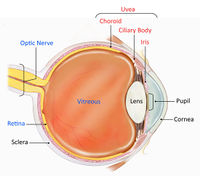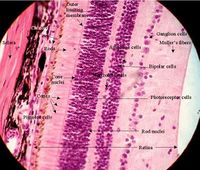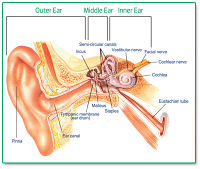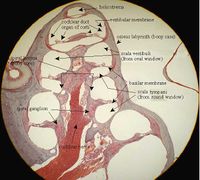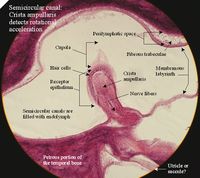Histologic:Chapter 19
Contents
Eye
Slide 285: Eye (H&E)
The eyeball is composed of three principal layers.
The outer layer, or sclera, consists of dense fibrous connective tissue. The sclera is the "white" of the eye. The sclera is continuous with the transparent substantia propria of the cornea. The exposed front surface of the eye, including the cornea, is also covered by a thin, non-keratinized stratified squamous epithelium.
The next layer, or choroid, consists of heavily pigmented loose connective tissue, including many melanocytes. The choroid is normally not visible behind the "white" of the sclera. The choroid is continuous with the iris; together the choroid and iris are called the uvea. A hole in this layer, the pupil, allows light to pass through.
The inner layer, or retina, includes two portions. The neural retina is the photoreceptive, imaging-processing tissue. And the pigmented epithelium lies behind the neural retina; it also extends forward to line the iris. The lens is a specialized epithelial structure, suspended behind the pupil.
The anterior chamber, the space between the iris and the cornea, is filled with aqueous humor. And the posterior chamber lies behind the iris.
Cornea
The cornea consists of a thin surface epithelium (non-keratinized stratified squamous epithelium) overlying a layer of dense fibrous connective tissue, called the substantia propria. The epithelium of the cornea is continuous with the epithelium of the conjunctiva, both that of the eyeball itself and that of the inside of the eyelid; however the corneal epithelium is very thin (only a few cells thick) which leads to its transparency. The basement membrane between the corneal epithelium and the substantia propria is exceptionally thick and is called Bowman's membrane. Collagen of the cornea is organized into extremely regular layers. All the collagen fibers in one layer arranged in parallel, and alternating layers run in different directions. Corneal connective tissue has no blood vessels. Even though cells of the cornea are not very active metabolically, they still need oxygen and nutrients. As long as the cornea is in direct contact with air, oxygen can be absorbed directly and nutrients can diffuse into cornea from the aqueous humor. Cells of cornea are limited to fibroblasts and there are no blood vessels so there are no immune-system components; hence corneal tissue can be transplanted without need for careful tissue typing.
At the inner surface of the cornea, a thick basal lamina (Decemet's membrane) separates the substantia propria from a layer of simple low cuboidal epithelium, called the corneal endothelium.
Corneal epithelium contains free nerve endings. Since pain seems to be the only sensory modality that functions for corneal tissue, biologists long ago decided that free nerve endings elsewhere may also represent pain fibers.
Iris
Functionally, the iris is a rather simple opaque ring surrounding and controlling the diameter of its central aperture - the pupil. A ring of smooth muscle surrounding the pupil comprises the pupillary sphincter. The color of the iris ("eye color") results both from scattering of light by its trabecular meshwork of collagen fibers and from absorption of light by melanin granules in scattered melanocytes. Variations in eye color result from individual differences in the distribution and density of melanocytes and trabecular meshwork.
Lens
The lens is an isolated island of epithelial tissue with an anterior layer that is simple cuboidal and a posterior layer consisting of elongated cells, called lens fibers that are packed with lens protein. The shape of the lens (and hence its focal length) is determined by tension exerted through the suspensory fibers, controlled by smooth muscle of the ciliary body.
Ciliary Body and Suspensory Fibers (zonules)
Deep to the limbus (i.e., the site where the cornea meets the sclera), the choroid layer is thickened into the ciliary body. The ciliary body is a ring of smooth muscle fibers arranged concentrically around the opening in which the lens is suspended. The lens is suspended from the ciliary body by thin fibers of collagen, called suspensory fibers or zonules. Together, the ciliary body and suspensory fibers control the shape of the lens. The surface of the ciliary body is covered by an extension of the embryonic optic cup and small projections of this tissue from the ciliary processes, which secretes the aqueous humor. Aqueous humor flows from its site of formation in the posterior chamber (i.e., behind the iris) through the pupil into the anterior chamber. From there it drains into the canal of Schlemm and hence into venous drainage. An imbalance between the formation and drainage of aqueous humor can create increased pressure leading to glaucoma.
Retina
The retina consists of two distinct layers, the neural retina (often called simply "the retina") and the pigmented epithelium.
The neural retina is the light-sensitive tissue of the eye. The photoreceptor cells (rods and cones) are located in the back of the retina, so light must pass through all of the layers of the neural retina before getting to the receptors. And the blood vessels which serve the retina are spread across the front surface, so light on its way to the receptors must also pass by the blood vessels. The nerve fibers which eventually travel from the eye through the optic nerve must pass through the layers of the retina, leaving a "blind spot" where they do so.
Cells comprising the neural retina form several layers.
- The innermost layer is the inner limiting membrane, a basal lamina separating nervous tissue of the retina from connective tissue of the vitreous humor.
- The layer of nerve fibers contains axons from ganglion cells which travel across the retina to the optic nerve and hence past the optic chiasm into the optic tract and into lateral geniculate nucleus of the thalamus.
- The ganglion cell layer contains the cell bodies of ganglion cells, the cells whose axons project to the brain.
- The inner plexiform layer contains dendrites of ganglion cells synapsing with axons of bipolar cells.
- The inner nuclear layer contains the cell bodies of bipolar cells
- The outer plexiform layer contains dendrites of bipolar cells synapsing with axons of photoreceptor cells.
- The outer nuclear layer contains the cell bodies of receptor cells.
- Between the outer nuclear layer and the receptor layer is the site of the outer limiting membrane, a basal lamina bounding the neural retina.
The outer segments (rods and cones) of the receptor cells penetrate the outer membrane to contact the pigmented epithelium.
- The receptor layer contains the photoreceptive outer segments (rods and cones) of receptor cells.
Photoreceptor cells come in two types, rods and cones. Rods are sensitive to dim light and provide night vision. Rods are more numerous in the peripheral retina. Cones need brighter light and provide daytime color vision. Cones are more prevalent in the vicinity of the fovea.
Ear
The ear has three distinct regions -- outer ear, middle ear, and inner ear.
The outer ear includes the pinna (the visible ear, consisting mostly of skin and cartilage) and the ear canal. The latter is lined by keratinized stratified squamous epithelium. This lining differs from skin by the presence of specialized ceruminous (ear-wax) glands.
The middle ear is basically a space, communicating via the eustacian tube with the oropharynx. It is lined by a very thin non-keratinized stratified squamous epithelium. Spanning the space of the middle ear are the three middle ear bones, the malleus (hammer), incus (anvil), and stapes (stirrup).
The eardrum is a thin membrane separating the outer ear from the middle ear. It is sandwich of tissues, with keratinized stratified squamous epithelium facing the outer ear, non-keratinized stratified squamous epithelium facing the middle ear, and a very thin layer of connective tissue in between.
The inner ear is the portion of the ear which contains sensory receptors.
Inner Ear
The inner ear consists of fluid-filled sacs (membranous labyrinth) that lie in cavities in the temporal bone of the skull (bony or osseous labyrinth). The inner ear contains sense organs serving both balance and hearing. Head position (i.e., gravity; also linear acceleration) is sensed by the otolith organs of the saccule and utricle. Head rotation (i.e., angular acceleration) is sensed by the cristae ampularis of the semicircular canals. And hearing is sensed by the organ of Corti within the scala media of the cochlea. All of these senses of the inner ear utilize the same mechanoreceptor cell type: epithelial hair cells.
Hair cells, the specialized mechanoreceptor cells of the auditory and vestibular systems, are found in several positions along the chambers and passageways of the membranous labyrinth. Hair cells are basically columnar epithelial cells. At the apical end of each hair cell is a set of "hairs" (cytoplasmic projections, kinocilium and stereocilia) embedded in a mass of extracellular jelly. At the basal end of each hair cell are synapses onto sensory axons. A hair cell responds when movement of the extracellular jelly displaces its kinocilium and stereocilia. Displacement of the kinocilium and stereocilia alters conductance of ion channels, in turn affecting release of neurotransmitter onto the associated sensory axon. (These axons project along the auditory and vestibular nerves, cranial nerve VIII).
Semicircular Canals
Each semicircular canal of the bony labyrinth is a hollow passageway looping out from and back to the vestibule. Within each of these passageways is a semicircular canal of the membranous labyrinth. At one end of each membranous semicircular canal is a small enlargement called the ampulla. Within each ampulla is a ridge or "crest" called the crista that is covered with hair cells. A small mass of jelly, called the cupola ("cap") rests on top of the hair cells of the crista. The hair cells of the ampullae respond to angular acceleration (i.e., rotation of the head)
There are three semicircular canals in each ear, oriented in three mutually-perpendicular planes. Rotation of the head in any direction will cause inertial fluid movement in one or more of the semicircular canals.
Cochlea
Slide 286: Ear Cochlea (H&E)
The cochlea houses an elaborate configuration of membranous labyrinth and hair cells, called the organ of Corti, designed for auditory reception. The basic shape of the cochlea is that of a snail-shell, or tapering helix. The spiraling tunnel that forms the cochlea of the bony labyrinth is divided into three distinct channels by portions of the membranous labyrinth attached to bony ridges. The central column of the helical cochlea contains axons serving the organ of Corti on their way to the auditory nerve.
Organ of Corti
The organ of Corti is an elaborate structure with more named parts than the rest of inner ear. The organ of Corti is a long strip of tissue that extends the length of the scala media, from the base of the cochlea to its apex. Within the complex strip of tissue that comprises the organ of Corti are specialized sensory hair cells. The whole organ of Corti rests on the basilar membrane which supports the basal ends of the hair cells in the organ of Corti. The apical ends of hair cells touch the tectorial membrane, a "shelf" of jelly that is supported immovably on the spiral lamina. When the basilar membrane flexes in respond to sound waves (i.e., pressure waves delivered to inner-ear fluid by the middle-ear ossicles), the organ of Corti, including its hair cells, also moves. Thus, when the basilar membrane is moved by pressure waves (i.e., sound), the hair cells move relative to the tectorial membrane, causing stimulatory deflection of the apical ends of the hair cells.
Endolymph and Perilymph
The membranous labyrinth is filled with endolymph and is surrounded by perilymph. Endolymph is a unique fluid, with high K+ concentration and very low Na+ concentration. This endolymph provides the proper ionic environment for hair cell function. Endolymph is secreted by cells of the stria vascularis, along the scala media of the cochlea.
In the vestibular system (surrounding the saccule, utricle, and semicircular canals), perilymph simply provides a cushioning support for the membranous labyrinth.
In the cochlea, perilymph of the ascending scala vestibuli and the descending scala tympani conveys pressure waves (sound) across the scala media. Pressure waves flex the basilar membrane and thereby stimulate hair cells of the organ of Corti.
| ||||||||||||||||||||||||||||||||||||||||||||||||||||||||||||||
